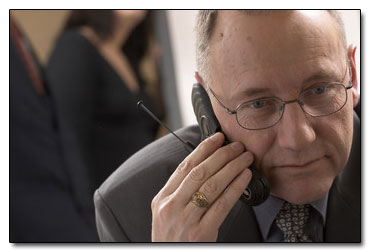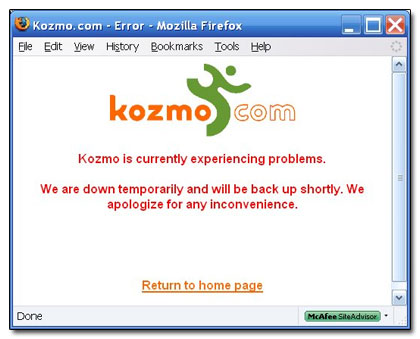6 'World-Changing' Inventions (That Didn't Change Shit)

The last 50 odd years have seen the introduction of some of the most life-changing inventions ever created. Some of them, like the Internet, the iPod, or the fleshlight, are so useful or cool that they become an inescapable part of our daily lives. Others, well, not so much. And no amount of hype could save them.
The Video Phone

How It Was Supposed To Change The World:
As early as 1910, people were imagining a wonderful future where they could see the person they were talking to miles away while still being able to enjoy the privacy of being pantless off screen. Videophones were standard future tech in science fiction (hell, imagine Star Trek without the bad guy threatening the crew on the giant wide screen monitor that apparently works with all alien camera technology).
So companies have been tinkering with videophone systems for decades, and AT&T had an easy to use prototype up and running by the 60s. By 1970, the picture phone was available for use in New York, Washington, Chicago and Pittsburgh. Major companies like Westinghouse had units installed in their corporate headquarters.

The video wasn't great but it didn't matter. The grainy technicolor future was here!
How It Didn't Change Shit:
Besides costing $1500 for the phone, the service cost over $90 bucks a month. Back in 1970, most people's disposable income was tied up in polyester shirts and cocaine, leaving little room for insanely expensive talky boxes. But the real nail in the coffin was the fact that people didn't want to use videophones nearly as much as everyone thought they did.
Sure, it was fun to see the person you were talking to at first, but once the novelty wore off it got weird. People didn't look at the camera when they talked, they looked at the screen. Even in webcams today, you don't look at the girl you're paying $5.95 a minute, you look down and to the left. The reason face-to-face contact is so valued by people, aside from the chance to score a peripheral glance at some boob, is the human eye contact. And the videophone didn't allow any.

Another unforeseen problem was that people liked being able to see the person they were talking to, but didn't really want anyone to see them. With a regular phone you can answer safe in the knowledge that no one knows how sad your life is. But with a video phone, you can't hide the fact you're eating sandwiches on the toilet.
Is There Any Hope?
Sure, webcams have become ubiquitous, but most people use those to masturbate with strangers. Somehow that doesn't feel the same when you're using your home phone talking to grandma. Many cellphones have the capability to send and receive video calls, it's just a matter of most people not giving a damn.
It's useful for some groups,such as the deaf who can use it to sign, and for various medical and diagnostic purposes. Outside of those specialized uses, it seems to be doomed to always be a novelty, niche product.
Olestra

How It Was Supposed To Change The World:
Generally speaking, it's hard to spend your life wallowing in Pabst and pork rinds and then ooze into some bicycle shorts for a round of squat thrusts without looking like a complete troll. Wouldn't it be great if there was a magical product that let you stuff your greasy pie-hole without having to worry about breaking the toilet? Well in 1998, it looked that product might have arrived.
Accidentally discovered by chemists at Proctor and Gamble in 1968 who were probably trying to find some way to make birth control come in Skittles flavors, Olestra is a food additive that can be used as a substitute for fat. For a world in love with chips, donuts and bacon-wrapped bacon, Olestra should have been the second coming of Jesus. Sweet, greasy Jesus.

Sure, there have been other fat substitutes before, but they either didn't work or made the food taste like, well, some chemical that came out of a lab. Olestra was different. A magic bullet that reduces fat but didn't leave an aftertaste like axle grease. Its downfall can be traced to the two most horrible words in the English language: anal leakage.
How It Didn't Change Shit:
Olestra-filled products initially flew off the shelves. In one year alone, $400 million worth of the fat substitute-filled snacks were sold. Olestra looked like the best idea since people stopped letting Rob Schneider make movies. People started to imagine a world where they could eat like pigs and still be thin without sticking their fingers down their throats.
In 2000, sales of Olestra had halved. Late night talk show hosts and hack comedians everywhere joked about it. The product that was supposed to change the way the world snacked was a bust. Why? It all came down to the warning label:
Olestra may cause abdominal cramping and loose stools.

In fairness, eating just a few Olestra-laden chips wasn't going to make you Spackle your shorts with greasy ass jelly. The side effect usually only occurred if someone ate an excessive amount of Olestra in a really short time. However, even a small chance of anal leakage is still too much of a chance for even the most Cheezie-addicted customers.
Is There Any Hope?

No need to cry for the miracle product that was Olestra. Even though the FDA eventually removed the anal leakage warning because, apparently, no one was having anal leakage, people didn't really give a shit, so to speak. Rather than call it a total bust, Proctor and Gamble did the next best thing and turned Olestra into an industrial lubricant for small power tools.
So feel free to lick your drill next time you bust it out safe in the knowledge it won't actually cause anal leakage. Probably.
WebTV

How It Was Supposed To Change The World:
Back in the carefree days of the early 90s, companies were eager to expand the growth of the Internet beyond bored office workers, pornography enthusiasts and white supremacists, looking for a way to get "mom" in to cyberspace. In 1996, WebTV looked like it had the perfect solution.

Sweetheart, what's a goatse?
For about a third of the cost of a new PC, the technologically unsavvy could surf for pictures of cute cats and get fleeced in 419 scams through their TV, and right from the comfort of their sofa.
How It Didn't Change Shit:
While it originally proved quite popular, WebTV was not without its problems. For one, it was woefully out of its league with a 33.6 kb/s modem, no hard drive and 8 MB of RAM (yes, bad for even those days). It also had no operating system, so software had to be downloaded directly from WebTV. This made it really easy to use, but it also meant that WebTV had to pay big bucks to companies like RealPlayer to make their applications available. But the real problem was the customers.
Having the technologically retarded as your customer-base means you're going to have a lot more customer service issues. Users of WebTV were constantly asking for help with the simplest of questions about the service. How do I check my e-mail? Why would a cat even ask if it can have cheeseburger?

"Hey, I was looking for Discovery Channel and I found porn but now I want the porn and I can't find it anymore. What's the porn I was looking at?"
At the same time, customers rarely clicked on ads or used the shopping features, two streams of revenue WebTV was sure customers would provide. And it didn't help that PCs got a lot faster and cheaper. WebTV didn't die, but it failed to live up to its promise to bring grandma to the Internet.
Is There Any Hope?
WebTV at some point realized they sucked but had an out: Microsoft. Microsoft bought the company and turned it into MSN TV, well aware that they had their own giant customer base of idiots and thus the infrastructure to deal with them. They're still plugging along, serving that select group of customers who 1) want to surf the Net 2) refuse to leave the couch and 3) have never heard of a laptop.
Online Delivery... Everything

How It Was Supposed To Change The World:
The entire dot-com bubble was built on the belief that soon, every single aspect of our lives would be radically reordered around the Internet, based on the scientific principle that a thing that is growing will continue to grow, in every direction, forever.
Did we say "scientific"? We meant "fucktarded." Just because it changed some things, doesn't mean it was going to change everything. But don't tell that to companies like Kozmo and Webvan.com, who made huge piles of start-up money based on the idea that within a few years, everything from a gallon of milk to a pack of matches could be delivered to your door with the click of a mouse.

Surprise!
How It Didn't Change Shit:
Kozmo promised free, one hour delivery of anything you could buy. Whether you wanted a hot dog, a case of beer, 10 gallons of KY or all three, Kozmo would deliver it to you in an hour. And they wouldn't charge you a penny.
Those of you who stayed awake during economics are probably wondering how they expected to make any money. The plan was to make it the way every store does, by marking up products. The only problem is, you can only mark up a can of Coke so much before people won't buy it.
WebVan offered a similar service, promising groceries to your door within 30 minutes. While they had a good idea, the fact that no one at the company had ever worked in the grocery business before, and that they spent over $1 billion in infrastructure, including 115 $800 chairs, meant they couldn't live up to their promise of 30 minute Lucky Charms and Marlboros for long.

Is There Any Hope?
Amazon did well by starting small (books and such) and then slowly expanding their selections with time. And, these days they operate AmazonFresh around the Seattle area, delivering groceries and moving right back into territory that probably still smells of charred Webvan start-up cash. We're guessing if it doesn't make money fast, they won't stay in the cabbage delivery business for long.
Voice Recognition Everything

How It Was Supposed To Change The World:
Video phones weren't the only devices that turned up in almost every futuristic sci-fi story. Most also promised a future where you could turn out the lights, get a drink and have your ass loofah'd with a simple voice command. And it didn't seem so far-fetched, all we needed was some decent voice recognition software and the desire to not move a fucking inch.
These days there are tons of different types of software that can recognize speech. Researchers have been working for years to get it into hospitals for medical transcription, into the military for voice activated death machines and into homes to save people the indignity of walking across the room.
So why do we still have to turn on our TV by punching a damned button?

FUCK!
How It Didn't Change Shit:
Just ask doctors. They were supposed to be some of the main early adopters, since laborious transcription of their taped medical notes is a major expense for them. What they found was that most voice recognition software is about as smart as a drunken donkey (that is drunk because it's depressed over its recent severe head trauma).
Because every human voice is different, with regional accents and slurred words, training voice recognition software to understand you takes forever. And even then it's never 100 perfect accurate.
Likewise, the Air Force bailed on voice recognition for pretty much the same reasons. It turns out that most pilots won't use a product that might send their jets careening into the ground due to a mumbled command.

As for the rest of us, well, have you called tech support recently, and gotten "help" from the robot lady who tries to walk you through your problem via voice commands? How long did you last before you started screaming "AGENT" into the phone over and over?
Is There Any Hope?
Companies have lots of motivation to keep developing voice recognition: it lets them cut loose expensive human customer service workers and transcriptionists. So vendors will continue to sell the software and presumably improve it.
Meanwhile, the new line of Lexus luxury cars use voice commands for everything from climate control to navigation. We have no way of knowing how many of these drivers trying to go to "Bill's Donuts" wind up at "Dildo Hut."
The Segway

How It Was Supposed To Change The World:
No recent product in the last 50 years got the kind of hype the Segway did prior to release. Even though it's little more than a fancy scooter, the first people to lay eyes on it thought it was the second coming of Jesus. Sweet, scooter Jesus.
The buzz started well before the majority of people had even seen a Segway. In early 2001, word started to spread about an invention that would change the world. Journalist Steve Kemper fanned the flames of hype in his 2002 book, Code Name Ginger, which told the story of the development of the Segway and inventor Dean Kamen's attempts to get investors for their miracle invention.

And get them he did. The venture capitalist John Doerr said it was "as big as the Internet" and Apple honcho Steve Jobs said it was "as big a deal as the PC." Presumably both men, when showed a cigarette lighter, bowed down and declared it to be "our fiery overlord."
So whatever its quality as a transportation device, one thing was certain: the Segway could totally make smart people say stupid things.
How It Didn't Change Shit:
There were a lot of reasons the Segway failed to set the world on fire. For one, it's a fucking scooter. And not even cool like a Razor scooter. It's the Razor scooter's fat, anime-loving cousin. After months of being prepared for a revolution in transportation, the public was a little disappointed when the Segway turned out to be a podium on wheels instead of something cool, like rocket boots.
Oh, and it cost as much as a used car. And it was almost impossible to use it without looking like a complete asshole.

Kamen wasn't going to let his dream die just because people thought it was epic scale gay. As he said, "it's an alternative to walking. We can't let them call us a scooter." There was just one problem: Almost everyone called it a scooter. Consequently, it was illegal in many countries in the world to use a Segway on public streets or sidewalks for the first several years of the invention's existence.
Kamen sold a few, mostly to police departments and hilariously chubby mall cops, but in the end the Segway turned out to be one more thing that didn't live up to the hype. But at least it didn't make you shit your pants.
Is There Any Hope?
The good people at Segway are nothing if not persistent in their desire to make your lazy ass ride their little scooter. Since its massive flop on arrival, laws have been changed allowing the use of Segways in 43 states with several others having local regulations to allow them. Sweden and Denmark also recently overturned laws that prohibited the use of Segways.
As of March of 2009, 50,000 Segways had been shipped, a number they'd initially planned to reach back in 2003. So, hell, maybe by the year 2200 upwards of one in five people will be on a Segway. The rest of them will be getting laid.
Now check out the lucky bastards these inventors are envious of, in 5 Accidental Inventions That Changed The World. Or check out some stuff we only think we invented, in 11 "Modern" Technologies That Are Way Older Than You Think.
And visit Cracked.com's Top Picks to see some totally rad, new Transformers we invented out of the ones (all of them) that Bucholz broke.